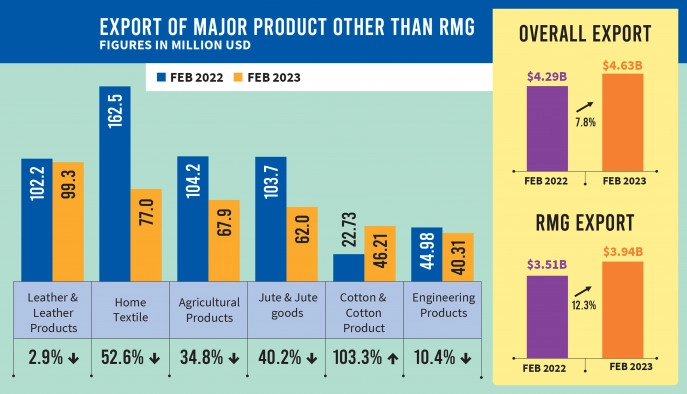The country’s overall merchandise exports increased 7.81% year-on-year in February to reach $4.63 billion, driven by significant growth in apparel shipments

Bangladesh’s RMG exports have been continuing to beat their strategic targets for the past four months due mainly to a shift of work orders from China as well as high-cost raw material.
The apparel exports earned $3.94 billion with a 12.31% year-on-year growth in the single month of February against the target of $3.88 billion, according to data published by the Export Promotion Bureau (EPB). Both knitwear and woven garments witnessed export growth of 16.94% and 7.45% to $2.09 billion and $12.84 billion, respectively, beating their targets.
The overall garment industry saw exports higher than their targets in six of eight months in the ongoing fiscal year (FY23). Apart from the four months in a row, starting in November, the exports saw such an achievement in July and August.
Businesspeople said RMG exports grew mainly because of the shipment of high-value apparel products, orders for which were shifted from China.
“The apparel sector experienced a high growth in exports in the month of February as the value of RMG goods increased owing to raw materials price hikes,” Bangladesh Garment Manufacturers and Exporters Association (BGMEA) Vice President Shahidullah Azim said told The Business Standard.
Mentioning that work orders are still inadequate, he added that the majority of exporters are running their units for below 8 hours due to the shortage in work orders. Bangladeshi apparel factories usually run for about 10 hours, including two hours of overtime.
Echoing Azim, BGMEA President Faruque Hassan said, “It is a very good sign that our export value is increasing but quantity remains sluggish although we have increased our production capacity over the past couple of years.”
“We are currently trying to bring orders from new markets as our major buyers from the USA and European markets have been going slow over the last few months due to global economic slowdown,” the BGMEA chief added and mentioned that they are investing to diversify products and focus on high demand man-made fibre items.

Faruque Hassan also acknowledged that high-value products shipped by some factories were the key drivers in the RMG export growth in previous months. “For example, one of our jacket manufacturers informed me that they are now producing jackets worth $100 per piece, while most Bangladeshi factories, including them, used to work for goods valued below $30,” he explained.
Shipments to new markets also contributed to the surge in RMG exports, he said, noting that exports to new markets saw a growth of over 19% in January year-on-year.
The country’s overall merchandise exports increased by 7.81% year-on-year in February to reach $4.63 billion, driven by significant growth in apparel shipments, according to EPB data.
The export earnings, however, declined compared to that of the previous three months, when it stayed above the $5-billion mark – $5.13 billion in January, $5.37 billion in December and $5.09 billion in November.
Sectors such as leather and leather goods, home textiles, agricultural products, jute and jute goods, engineering products, and frozen and live fish exports saw negative growth and missed their targets in the month.
$37b exports in 8 months
The Exports fetched a total of $37.08 billion in the first eight months of the current financial year (FY23), up 9.56% year-on-year growth. The earnings are much closer to the strategic target of $37.24 billion set for this period.
The apparel shipments earned $31.36 billion with a 14.06% year-on-year growth in July-February, which accounted for about 85% of national shipments. Of them, exports of knitwear apparel grew by 13.21% to $17.06 billion, while earnings from knitwear increased by 15.08% to $ 14.30 billion.
Among other sectors, export earnings from leather and leather goods during July-February of FY23 increased by 6.04% to $832.38 million, leather footwear export earnings grew by 2.48% to $486.82million, and non-leather footwear increased by 8.11% to $314.03 million, according to the EPB.
There were also notable dips in export earnings by some major export sectors. Agriculture product exports dropped by 26.96% to $623.18 million in the first eight months. Exports of jute and jute goods fell by 23.68% to $610.08 million, while frozen and live fish exports dipped by 21.56% to $318.95 million, the EPB data showed.
Earnings from home textile exports fell by 22.53% year-on-year to $769.86 million during this period.
LIKE | COMMENT | SHARE | SUBSCRIBE
বিস্তারিত জানতে লিঙ্কে ক্লিক করুন
Facebook Page ▶https://www.facebook.com/RMGBangladesh/
YouTube ▶ https://www.youtube.com/@RMGBangladesh
Twitter ▶ https://www.twitter.com/RMGBangladesh
Pinterest ▶ https://www.pinterest.com/RMGBangladesh/
Linkedin ▶ https://www.linkedin.com/company/rmgbd/
RMG_News
Bangladesh_Apparel_Industry
Bangladesh_Readymade_Garments_Sector
Thank You For
News SOURCE – The Business Standards Copy
















